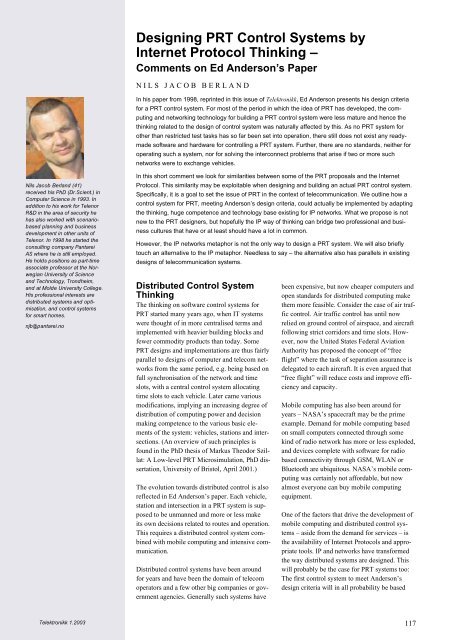Intelligent Transport Systems - Telenor
Intelligent Transport Systems - Telenor
Intelligent Transport Systems - Telenor
You also want an ePaper? Increase the reach of your titles
YUMPU automatically turns print PDFs into web optimized ePapers that Google loves.
Nils Jacob Berland (41)<br />
received his PhD (Dr.Scient.) in<br />
Computer Science in 1993. In<br />
addition to his work for <strong>Telenor</strong><br />
R&D in the area of security he<br />
has also worked with scenariobased<br />
planning and business<br />
development in other units of<br />
<strong>Telenor</strong>. In 1998 he started the<br />
consulting company Pantarei<br />
AS where he is still employed.<br />
He holds positions as part-time<br />
associate professor at the Norwegian<br />
University of Science<br />
and Technology, Trondheim,<br />
and at Molde University College.<br />
His professional interests are<br />
distributed systems and optimisation,<br />
and control systems<br />
for smart homes.<br />
njb@pantarei.no<br />
Telektronikk 1.2003<br />
Designing PRT Control <strong>Systems</strong> by<br />
Internet Protocol Thinking –<br />
Comments on Ed Anderson’s Paper<br />
NILS JACOB BERLAND<br />
In his paper from 1998, reprinted in this issue of Telektronikk, Ed Anderson presents his design criteria<br />
for a PRT control system. For most of the period in which the idea of PRT has developed, the computing<br />
and networking technology for building a PRT control system were less mature and hence the<br />
thinking related to the design of control system was naturally affected by this. As no PRT system for<br />
other than restricted test tasks has so far been set into operation, there still does not exist any readymade<br />
software and hardware for controlling a PRT system. Further, there are no standards, neither for<br />
operating such a system, nor for solving the interconnect problems that arise if two or more such<br />
networks were to exchange vehicles.<br />
In this short comment we look for similarities between some of the PRT proposals and the Internet<br />
Protocol. This similarity may be exploitable when designing and building an actual PRT control system.<br />
Specifically, it is a goal to set the issue of PRT in the context of telecommunication. We outline how a<br />
control system for PRT, meeting Anderson’s design criteria, could actually be implemented by adapting<br />
the thinking, huge competence and technology base existing for IP networks. What we propose is not<br />
new to the PRT designers, but hopefully the IP way of thinking can bridge two professional and business<br />
cultures that have or at least should have a lot in common.<br />
However, the IP networks metaphor is not the only way to design a PRT system. We will also briefly<br />
touch an alternative to the IP metaphor. Needless to say – the alternative also has parallels in existing<br />
designs of telecommunication systems.<br />
Distributed Control System<br />
Thinking<br />
The thinking on software control systems for<br />
PRT started many years ago, when IT systems<br />
were thought of in more centralised terms and<br />
implemented with heavier building blocks and<br />
fewer commodity products than today. Some<br />
PRT designs and implementations are thus fairly<br />
parallel to designs of computer and telecom networks<br />
from the same period, e.g. being based on<br />
full synchronisation of the network and time<br />
slots, with a central control system allocating<br />
time slots to each vehicle. Later came various<br />
modifications, implying an increasing degree of<br />
distribution of computing power and decision<br />
making competence to the various basic elements<br />
of the system: vehicles, stations and intersections.<br />
(An overview of such principles is<br />
found in the PhD thesis of Markus Theodor Szillat:<br />
A Low-level PRT Microsimulation, PhD dissertation,<br />
University of Bristol, April 2001.)<br />
The evolution towards distributed control is also<br />
reflected in Ed Anderson’s paper. Each vehicle,<br />
station and intersection in a PRT system is supposed<br />
to be unmanned and more or less make<br />
its own decisions related to routes and operation.<br />
This requires a distributed control system combined<br />
with mobile computing and intensive communication.<br />
Distributed control systems have been around<br />
for years and have been the domain of telecom<br />
operators and a few other big companies or government<br />
agencies. Generally such systems have<br />
been expensive, but now cheaper computers and<br />
open standards for distributed computing make<br />
them more feasible. Consider the case of air traffic<br />
control. Air traffic control has until now<br />
relied on ground control of airspace, and aircraft<br />
following strict corridors and time slots. However,<br />
now the United States Federal Aviation<br />
Authority has proposed the concept of “free<br />
flight” where the task of separation assurance is<br />
delegated to each aircraft. It is even argued that<br />
“free flight” will reduce costs and improve efficiency<br />
and capacity.<br />
Mobile computing has also been around for<br />
years – NASA’s spacecraft may be the prime<br />
example. Demand for mobile computing based<br />
on small computers connected through some<br />
kind of radio network has more or less exploded,<br />
and devices complete with software for radio<br />
based connectivity through GSM, WLAN or<br />
Bluetooth are ubiquitous. NASA’s mobile computing<br />
was certainly not affordable, but now<br />
almost everyone can buy mobile computing<br />
equipment.<br />
One of the factors that drive the development of<br />
mobile computing and distributed control systems<br />
– aside from the demand for services – is<br />
the availability of Internet Protocols and appropriate<br />
tools. IP and networks have transformed<br />
the way distributed systems are designed. This<br />
will probably be the case for PRT systems too:<br />
The first control system to meet Anderson’s<br />
design criteria will in all probability be based<br />
117
















